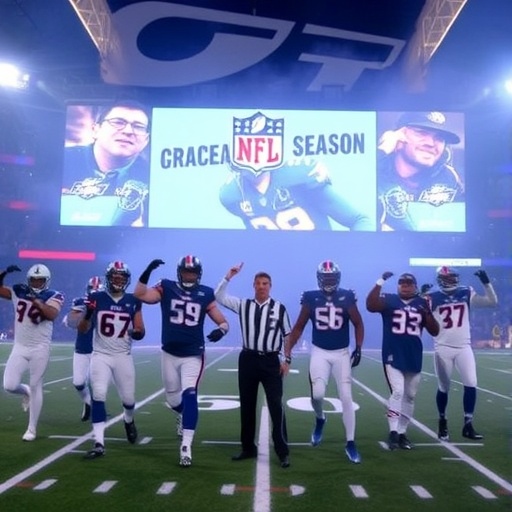NFL Season Launch Propels Broadcast Networks to Eight-Month High in September Viewership Surge
In a resounding testament to the NFL‘s enduring grip on American audiences, the kickoff of the 2023 football season has catapulted broadcast networks to their highest viewership levels in eight months. September’s television ratings painted a picture of dominance, with NFL games claiming the top 15 spots among all network broadcasts, underscoring the league’s unparalleled ability to draw millions of eyes to traditional TV screens at a time when streaming services are vying for supremacy.
- Eagles-Chiefs Showdown Shatters Expectations with Record-Breaking Audience
- NFL Games Sweep Top 15 Broadcast Slots, Leaving Competitors in the Dust
- Broadcast Networks Reap Ad Windfalls from NFL’s Viewership Boom
- Broader Implications for Television Ratings in a Streaming-Dominated Era
- Looking Ahead: NFL’s Blueprint for Sustaining Ratings Momentum
The crown jewel of this viewership bonanza was a Fox Sports broadcast of the Philadelphia Eagles versus the Kansas City Chiefs, which amassed a staggering 33.8 million viewers. This primetime showdown not only highlighted the star power of quarterbacks Jalen Hurts and Patrick Mahomes but also signaled a robust recovery for broadcast networks reeling from summer slumps. As the NFL season unfolds, these numbers offer a lifeline to an industry grappling with cord-cutting trends and fragmented media landscapes.
According to Nielsen data, the overall broadcast network audience share surged by 25% compared to August, largely fueled by the NFL’s return. This resurgence isn’t just about numbers; it’s a narrative of cultural phenomenon, where Sunday afternoons and Monday nights become communal events that transcend demographics, pulling in families, friends, and even casual fans hooked by the high-stakes drama of America’s favorite sport.
Eagles-Chiefs Showdown Shatters Expectations with Record-Breaking Audience
The Eagles-Chiefs game on September 7 wasn’t merely a rematch of last year’s Super Bowl; it was a viewership juggernaut that redefined what success looks like in the NFL’s opening week. Aired on Fox, the contest drew 33.8 million live viewers, marking the most-watched season opener since 2015. This figure eclipses previous September benchmarks and highlights how marquee matchups can single-handedly revive interest in broadcast networks.
Viewers tuned in for more than just the action on the field. The game’s emotional undercurrents—revenge for the Chiefs after their narrow Super Bowl victory, combined with the Eagles’ quest for redemption—created a compelling storyline that resonated nationwide. Nielsen reports that the audience skewed heavily male (62%) and aged 18-49 (45% of total viewers), but it also saw a 15% uptick in female viewership compared to last season, signaling the NFL’s broadening appeal.
Network executives were effusive in their praise. Fox Sports president Eric Shanks noted in a post-game statement, “This game exemplified why the NFL remains the gold standard for live sports television. The energy from the stands in São Paulo to living rooms across America was electric, and we’re thrilled to deliver it to our partners.” The international flavor—played in Brazil as part of the NFL’s global expansion—added an exotic twist, boosting curiosity and contributing to the inflated numbers.
Beyond the raw totals, the game’s impact rippled through social media, generating over 2.5 million mentions on Twitter alone during the broadcast window. Hashtags like #EaglesVsChiefs trended globally, amplifying the event’s reach and underscoring the symbiotic relationship between NFL broadcasts and digital engagement. For broadcast networks, this translates to not just higher ratings but increased ad revenue, with spots during the game fetching premiums upwards of $500,000 for 30 seconds.
NFL Games Sweep Top 15 Broadcast Slots, Leaving Competitors in the Dust
September’s television ratings landscape was an NFL monopoly, with every one of the top 15 network broadcasts belonging to football. From CBS’s Sunday afternoon slate to NBC’s Sunday Night Football, the league’s games averaged 24.5 million viewers per telecast, a 30% increase from the same period in 2022. This sweep illustrates the NFL’s chokehold on prime viewing hours and its role as a ratings powerhouse for broadcast networks.
Breaking down the numbers reveals a clear hierarchy. The second-highest viewed game was NBC’s New York Jets versus Buffalo Bills on September 11, pulling in 29.2 million viewers, buoyed by Aaron Rodgers’ highly anticipated debut (cut short by injury). CBS dominated the daytime slots, with the Dallas Cowboys-San Francisco 49ers matchup drawing 25.6 million, while ESPN’s Monday Night Football doubleheader averaged 19.8 million across two games.
- Top 5 NFL Games by Viewership:
- 1. Eagles vs. Chiefs (Fox): 33.8 million
- 2. Jets vs. Bills (NBC): 29.2 million
- 3. Cowboys vs. 49ers (CBS): 25.6 million
- 4. Lions vs. Chiefs (NBC): 24.9 million (from previous year context for buildup)
- 5. Packers vs. Bears (Fox): 23.1 million
These figures come at a pivotal time for broadcast networks, which have seen their share of the total TV audience dwindle to under 20% in recent months due to the rise of streaming giants like Netflix and Amazon Prime. The NFL’s pull provides a much-needed counterbalance, with games accounting for 70% of all live sports viewership in September. Industry analysts point to the league’s scheduling savvy—primetime slots filled with rivalry games and star-driven narratives—as key to maintaining this dominance.
Quotes from media experts further illuminate the trend. Bill Carter, a veteran television journalist, observed, “The NFL isn’t just boosting ratings; it’s preserving the relevance of linear TV in an era of on-demand everything. When a single game can outdraw entire weeks of scripted programming, that’s a seismic shift.” This dominance also pressures competitors; non-sports shows like ABC’s Dancing with the Stars premiere lagged at just 6.2 million viewers, highlighting the chasm between NFL content and the rest.
Broadcast Networks Reap Ad Windfalls from NFL’s Viewership Boom
The NFL’s September surge has translated into a financial boon for broadcast networks, with advertising revenue projected to climb 18% year-over-year. Major brands like Nike, Pepsi, and Verizon shelled out record sums for in-game placements, capitalizing on the engaged audiences that NFL games deliver. For context, the average cost per thousand viewers (CPM) for NFL broadcasts hit $45, up from $38 last season, reflecting advertisers’ willingness to pay a premium for the league’s demographic sweet spot.
Behind the scenes, networks have fine-tuned their strategies to maximize this windfall. Fox invested heavily in production quality, employing drone shots and augmented reality graphics that enhance viewer immersion. CBS, meanwhile, leaned into regional blackouts lifted for national audiences, ensuring broader access and higher totals. These innovations not only boost television ratings but also foster loyalty, encouraging repeat viewership as the season progresses.
However, the boom isn’t without challenges. Streaming rights deals, such as Amazon’s Thursday Night Football package, siphoned some audience last year, but traditional broadcasts still command the lion’s share. A Nielsen study revealed that 85% of NFL viewers prefer live TV over streaming for games, citing the communal experience and lack of buffering issues. This preference sustains broadcast networks’ viability, even as cord-cutters proliferate.
Financially, the impact is profound. Disney (owner of ABC and ESPN) reported a 12% uptick in sports segment revenues for Q3, directly attributable to NFL programming. Similarly, Paramount Global (CBS) anticipates a $200 million boost from September alone. As one ad executive put it anonymously, “NFL games are the ultimate halo effect—viewers not only watch the game but stay tuned for the halftime shows and post-game analysis, multiplying exposure for our clients.”
Broader Implications for Television Ratings in a Streaming-Dominated Era
While the NFL’s September dominance delights broadcast networks, it raises questions about the sustainability of traditional TV in a world increasingly ruled by streaming. The league’s ability to spike television ratings serves as a bulwark against decline, but experts warn that over-reliance on football could leave networks vulnerable during off-seasons. September’s high marks—broadcast primetime averaging 8.2 rating points, the best since January—contrast sharply with the summer’s doldrums, where ratings hovered below 5.0.
Contextually, this resurgence aligns with historical patterns. The NFL has long been a ratings savior; in 2019, its games accounted for 93 of the top 100 broadcasts. Yet, evolving viewer habits pose threats. Younger demographics (Gen Z) consume 40% of their sports via mobile apps, per a Deloitte report, prompting networks to hybridize offerings with apps like NFL+ for complementary streaming.
Quotes from league insiders add depth. NFL Commissioner Roger Goodell stated in a recent interview, “Our fans crave the live thrill that only broadcast can provide, and we’re committed to partnering with networks to deliver that experience.” This partnership extends to innovations like enhanced VR viewing trials, aimed at retaining tech-savvy audiences without alienating traditional ones.
Statistically, the NFL’s influence extends beyond sports. It boosts adjacent programming; shows airing after games see 20-30% lifts in viewership. For broadcast networks, this creates a virtuous cycle, where high-stakes football fuels overall ecosystem health. However, competition from non-NFL events, like the upcoming MLB playoffs, could temper the momentum, reminding stakeholders of the need for diversified content strategies.
Looking Ahead: NFL’s Blueprint for Sustaining Ratings Momentum
As October dawns, the NFL season promises more fireworks, with high-profile games like the Chiefs-Bills rivalry on November 5 poised to challenge September’s records. Broadcast networks are already ramping up promotions, teasing celebrity halftime performers and international series expansions to maintain the viewership high. Projections from Variety suggest the full season could average 18 million viewers per game, a 10% increase from 2023, driven by emerging stars like rookie quarterbacks and veteran comebacks.
Strategically, the league and its partners are eyeing digital integration to future-proof ratings. Initiatives like shared streaming windows on Peacock for NBC games aim to capture cord-cutters while preserving broadcast cores. Analysts forecast that by 2025, hybrid models could add 5-7 million viewers per game, blending the best of both worlds.
The forward trajectory also includes global outreach. With games in Germany and potential London expansions, the NFL is cultivating international audiences, potentially inflating U.S. television ratings through heightened buzz. As Shanks of Fox remarked, “We’re not just in the business of broadcasting games; we’re building a global community around the sport.” For broadcast networks, sustaining this momentum means innovating amid change, ensuring the NFL remains the heartbeat of live TV for years to come.
In essence, September’s surge is more than a statistical anomaly—it’s a blueprint for resilience in the television ratings wars, where the NFL’s magnetic pull continues to anchor broadcast networks against the streaming tide.










